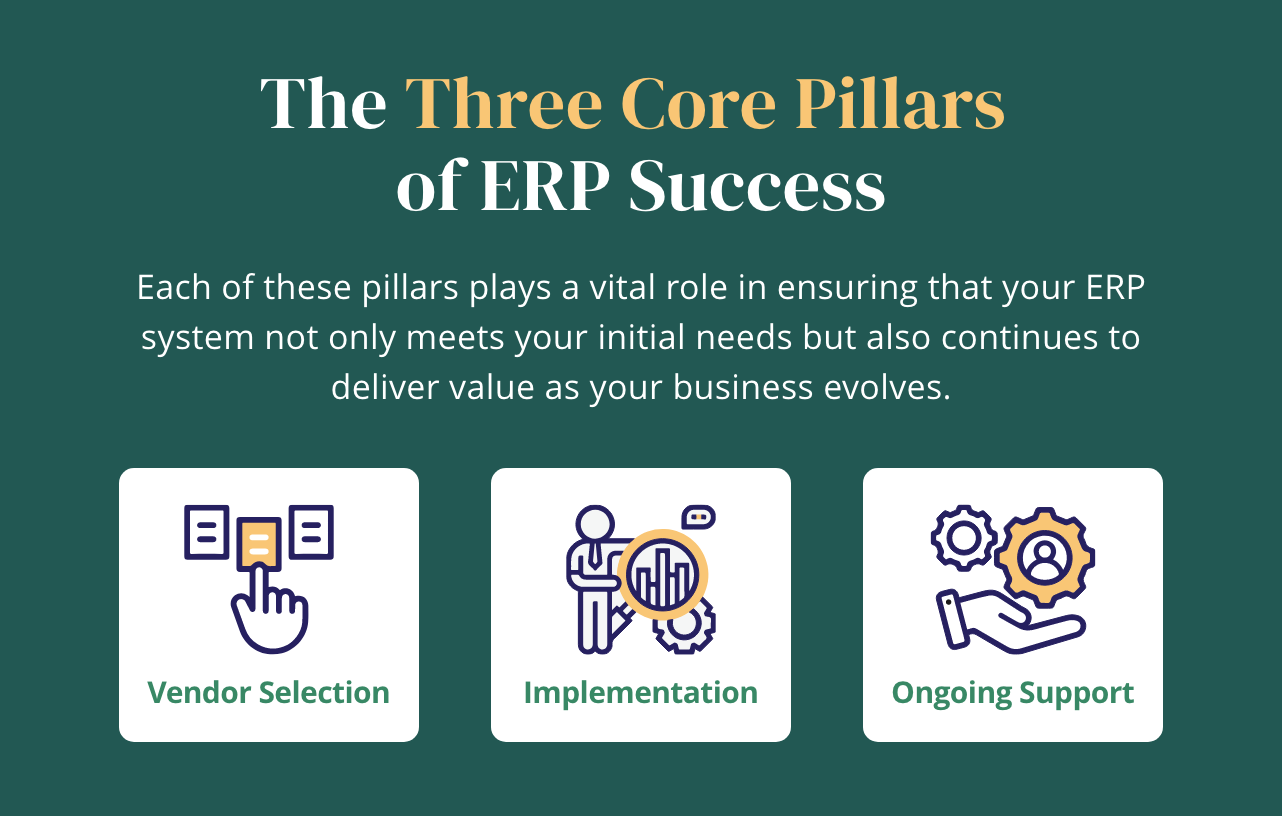Preparing for ERP: Setting the Foundation for Success

Table of Contents
Embarking on an Enterprise Resource Planning (ERP) journey is a significant milestone for any organisation. A successful ERP implementation can streamline operations, enhance productivity and provide real-time insights into your business. However, achieving these benefits requires meticulous preparation and a strategic approach. At MacroFin Consultants, we emphasise the importance of a solid foundation, which encompasses four core pillars: Preparation & Readiness, Vendor Selection, Implementation and Ongoing Support.
Today, we delve into the crucial first step: Preparation & Readiness.
The Importance of Preparation & Readiness
Preparation & Readiness is often the most overlooked yet vital phase in the ERP journey. Many organisations fall short here, swayed by polished sales pitches that don’t align with their unique requirements. At MacroFin, we believe that the time invested in thorough preparation is a determinant of ERP success.
Understanding Your Business Needs
The first step in preparing for an ERP system is to thoroughly understand your business processes, pain points and goals. This involves engaging with stakeholders across departments to gather insights into current workflows and identifying areas that need improvement. A comprehensive needs assessment ensures that your ERP solution is tailored to support your business’s specific requirements.
Setting Clear Objectives
Once you understand your needs, it’s essential to set clear, measurable objectives for your ERP implementation. These objectives should align with your overall business strategy and provide a roadmap for evaluating the success of the ERP system. Whether it’s improving supply chain efficiency, enhancing customer service, or providing better financial oversight, having defined goals will guide your entire ERP journey.
Change Management and Training
Preparation isn’t just about technology; it’s also about people. Change management is critical in ensuring that your team is ready to adopt the new system. This involves communicating the benefits of the ERP system, addressing concerns and providing comprehensive training. By fostering a culture of acceptance and readiness, you can mitigate resistance and enhance user adoption.
Avoiding the Sales Pitch Trap
One common pitfall in the Preparation & Readiness phase is falling for well-executed sales pitches that promise the moon but deliver far less. Vendors often highlight the most attractive features of their ERP solutions, but these may not align with your business needs.
Here’s how to avoid this trap:
-
- Conduct Independent Research: Don’t rely solely on vendor information. Seek out independent reviews, case studies and industry reports to get a realistic view of the ERP solutions you’re considering.
-
-
- Request Customised Demos: Insist on demonstrations that focus on how the ERP solution will handle your specific business processes, rather than generic overviews.
-
- Evaluate Total Cost of Ownership: Consider all costs associated with the ERP system, including implementation, training, maintenance and potential upgrades. This will give you a clearer picture of the long-term investment required.
-
- Seek References: Ask vendors for references from companies similar to yours. Contact these references to learn about their experiences, challenges and the support they received.

The Three Core Pillars of ERP Success
1. Vendor Selection

Choosing the right ERP vendor is a critical decision that can make or break your ERP project.
Here are key factors to consider during the vendor selection process:
Industry Experience: Look for vendors who have a proven track record in your industry. They will have a better understanding of your specific needs and challenges and their solutions are likely to be more aligned with industry best practices.
Product Flexibility and Scalability: Ensure that the ERP solution is flexible and scalable enough to grow with your business. The system should be able to adapt to changes in your operations and accommodate new business processes as they arise.
Robust Support Services: Post-implementation support is crucial for the long-term success of your ERP system. Choose a vendor that offers comprehensive support services, including technical assistance, training and regular updates.
Innovation and Upgrades: Technology evolves rapidly and so should your ERP system. Select a vendor committed to ongoing innovation and regular upgrades to keep your system up-to-date with the latest features and improvements.
Vendor Stability and Reputation: Evaluate the financial stability and market reputation of the vendor. A financially stable vendor with a strong reputation is more likely to provide reliable support and continue innovating their products.
2. Implementation

A structured implementation plan is essential to ensure that your ERP system is deployed smoothly and efficiently. Consider the following elements for a successful implementation:
Realistic Timelines: Set realistic timelines for each phase of the implementation. Rushing the process can lead to errors and oversights, while overly extended timelines can cause delays and increased costs. A balanced approach ensures a thorough and efficient deployment.
Clear Responsibilities: Assign clear responsibilities to team members involved in the implementation. This includes project managers, IT staff and end-users. Defined roles and accountability help keep the project on track and ensure that tasks are completed as planned.
Engagement and Communication: Keep your team fully engaged throughout the implementation process. Regular communication, progress updates and feedback sessions are vital to address concerns and make necessary adjustments. This fosters a sense of ownership and ensures that everyone is aligned with the project goals.
Data Migration and Testing: Data migration is a critical step in the implementation process. Ensure that your data is accurately transferred from your legacy systems to the new ERP system. Rigorous testing is essential to identify and resolve issues before going live, ensuring that the system operates as expected.
Training and Change Management: Provide comprehensive training to all users to ensure they are comfortable with the new system. Effective change management strategies help mitigate resistance and facilitate a smooth transition.
3. Ongoing Support

Post-implementation support is essential to maximise the value of your ERP system and ensure its long-term success. Key aspects of ongoing support include:
Technical Assistance: Regular technical support is crucial for resolving any issues that arise and ensuring that the system runs smoothly. Choose a vendor that offers accessible and responsive technical support services.
System Optimisation: Periodically review and optimise your ERP system to enhance performance and efficiency. This involves fine-tuning configurations, updating processes and incorporating user feedback to improve overall functionality.
Regular Updates and Upgrades: Stay current with regular system updates and upgrades provided by the vendor. These updates often include new features, security enhancements and performance improvements, keeping your ERP system in line with the latest technological advancements.
Continuous Training: Ongoing training ensures that your team stays proficient in using the ERP system. As new features are introduced and business processes evolve, continuous training helps users stay up-to-date and fully utilise the system’s capabilities.
Proactive Monitoring and Maintenance: Implement proactive monitoring and maintenance practices to identify and address potential issues before they impact your operations. Regular system health checks and performance assessments help maintain optimal system performance.
At MacroFin Consultants, we understand that the journey to a successful ERP system starts long before the first line of code is written. Preparation & Readiness, when done right, lays a strong foundation for the subsequent phases of Vendor Selection, Implementation and Ongoing Support. By taking the time to thoroughly prepare and align your ERP solution with your business needs, you can avoid common pitfalls and set your organisation on the path to success.
Ready to embark on your ERP journey?
Let MacroFin Consultants guide you through every step, ensuring that your investment delivers the value and efficiency your business deserves.






Responses